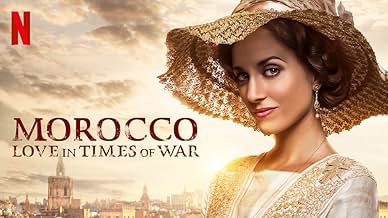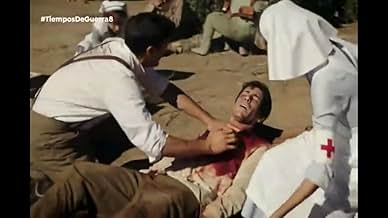Melilla, 1921: Spanien verliert im Rif-Krieg immer mehr Soldaten.Melilla, 1921: Spanien verliert im Rif-Krieg immer mehr Soldaten.Melilla, 1921: Spanien verliert im Rif-Krieg immer mehr Soldaten.
- Auszeichnungen
- 1 Nominierung insgesamt
Folgen durchsuchen
Empfohlene Bewertungen
Pro's: The characters are appealing. The story line is interesting. For the most part, the acting is pretty good. This isn't a deep, serious watch- even considering the subject matter. This was a historical situation I wasn't aware of, so I always appreciate cinema that spurs me on to learn more about what was going on.
Con's: I would say the "getting together-breaking apart" aspect of the love story between Julia and Fidel got to comic proportions by the end.In fact, that seemed to be a common theme with ALL the romantic plot lines in the series and it was getting tiresome. That said, I hope there is a season 2. :)
When writing this, the IMDB reviews thus far have just been soap boxes for hatred of the Spanish or the Moroccans. However, this is a T.V. show about compassion. Melilla, Ceuta, and the Canaries have been a part of Spain for centuries, so it's understandable that the Spanish in the 1920s saw it as a home, and so did the indigenous people from nearby areas. This is a T.V. show about forgiveness and seeing the humanity in people who are different.
It's a telenovela (which is a genre), so you can only compare it to other telenovelas, not T.V. shows in general. The acting is great by telenovela standards and the costumes and sets are beautiful. This show has Muslim Middle Easterners, interracial relationships, and interfaith relationships, which are all rare things in telenovelas. Timely, wouldn't you say?
Javierruiberriz,you should study more history and vaccinate yourself against patriotism: Ceuta and Melilla did exist before the Portuguese and Spanish intromission and expansionism, under the pretext of protecting themselves. Ceuta from Phoenician establishments, through the Romans, the Byzantines and various Germanians until the Arab invasion and intermittences between the kingdom of Castile and North African dynasties. It was not until 1415 that his story is as we know it. Melilla also has Phoenician ancestry; First it was called Punic Rusadir and its current name could come from Tamazight "Tamlilt". Abderramán III created the Taifa de Melilla in 927, which was integrated into the Caliphate of Córdoba and maintained close relations with the Muslim Hispania of al-Andalus. In 1497 everything changed and its future became linked to Spain via the Medina-Sidonia.
Ceuta and Melilla have never ever belonged to Morocco, javierruiberriz? Are and always be Spanish? Do you still believe that? Spain was a nation when the hosts of Tarik arrived in Spanish territory in 711? Did they already exist in 711 Sevilla and Madrid? All of Morocco was only tribes for the time? I think you should know and heal yourself of your ignorance or maledicted nationalism. Idrisíes, Meriníes and Hafsíes were not simple tribes, but empires with their domains to both sides of the Straits.
Ceuta and Melilla have their North African past, it's just a fact that you have nationalist sentiments.And about the series ... it's as manic as it is flimsy.
Very entertaining. Good to learn Spanish. Great acting.
I like the vibes eventhough they are predictable as in Las Chicas del Cable & Gran Hotel.
Bring on season 2 please.
I wanna see 3 weddings;)
Hi there.
We're currently on the 4th episode of the 1st season and so far so good. It reminds me of a good, old fashion soap opera. The sets are quite elaborate and we're enjoying the outdoor location scenes a lot.
I usually change the channel when I see a show with subtitles but decided to tough it out for the sake of my mother who is truly enjoying the show,
As per my question, I was wondering what year it was shot and more importantly, is there going to be a 2nd season? If so, can you tell me when it starts?
Thanks in advance,
Lori
WUSSTEST DU SCHON:
- PatzerIn the opening credits there are animated drawings. One such animated drawing depicts an entire rifle shell (the bullet and the attached casing) as a single moving projectile. Further, it shows the entire shell passing through a man's lower leg and emerging whole (bullet with casing attached and the bullet not deformed) on the other side of the leg.
This is not how this ammunition works. The casing (the shell's casing) never leaves the firearm; only the bullet travels down the barrel and is expelled through the muzzle of the firearm.
Obviously the production people have no knowledge of how firearm ammunition functions.
- VerbindungenReferenced in El hormiguero: Amaia Salamanca y Álex García (2017)
Top-Auswahl
Melde dich zum Bewerten an und greife auf die Watchlist für personalisierte Empfehlungen zu.
- How many seasons does Morocco: Love in Times of War have?Powered by Alexa
Details
- Erscheinungsdatum
- Herkunftsland
- Sprachen
- Auch bekannt als
- Morocco: Love in Times of War
- Drehorte
- Tenerife, Canary Islands, Spanien(Location)
- Produktionsfirmen
- Weitere beteiligte Unternehmen bei IMDbPro anzeigen
- Laufzeit1 Stunde 10 Minuten
- Farbe
Zu dieser Seite beitragen
Bearbeitung vorschlagen oder fehlenden Inhalt hinzufügen



































